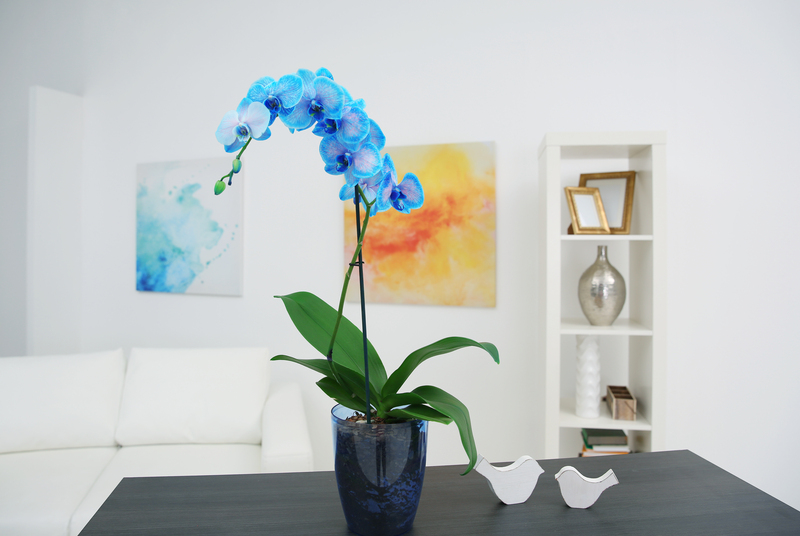Container gardening for urban environments
Posted on 20/06/2025
Container Gardening for Urban Environments: A Comprehensive Guide
Introduction to Urban Container Gardening
Container gardening has gained immense popularity in modern urban environments, where access to traditional garden spaces is often limited. With skyrocketing urbanization, the need for green spaces persists, and container gardening emerges as a creative and practical solution for city dwellers. Whether you live in an apartment with a small balcony, a condo with a rooftop, or a townhouse with limited yard space, you can nurture a lush garden using pots, troughs, and other containers.

Why Choose Container Gardening?
Container gardening in cities is more than a trend--it's an efficient way to maximize available space, improve air quality, and bring nature closer to urban lives. Here are a few reasons why container gardens thrive in urban environments:
- Space optimization: Containers fit in tight corners, windowsills, patios, or rooftops.
- Flexibility: Plants can be moved to optimize lighting or change your garden layout at any time.
- Soil control: You avoid contaminated urban soils by using store-bought or custom-mixed soil blends.
- Pest management: Elevated and portable containers make it easier to protect plants from pests.
- Aesthetic value: Adds visual appeal and greenery to concrete-heavy environments.
- Year-round gardening: Portability allows for seasonal protection and indoor-outdoor transitions.
Choosing the Right Containers
Container choice is the foundation of a thriving urban garden. Urban gardeners must assess their available space, accessibility, and the types of plants they wish to grow.
Types of Containers for Urban Spaces
- Terracotta Pots: Classic, porous, and attractive--ideal for Mediterranean herbs and succulents.
- Plastic Containers: Lightweight and affordable, suitable for balconies or rooftop gardens.
- Self-watering Pots: Excellent for busy urbanites; these help maintain consistent soil moisture.
- Hanging Baskets: Perfect for maximizing vertical space and growing trailing plants like strawberries or flowers.
- Raised Planter Boxes: Great for larger-scale container vegetable gardening.
- Recycled Materials: Upcycle crates, cans, or old buckets for an eco-friendly touch.
*Tip: Always ensure containers have adequate drainage holes to prevent root rot.
Container Size Considerations
Bigger is usually better when it comes to pots--larger containers hold more soil, which retains moisture longer, buffers temperature changes, and supports bigger root systems for healthy urban plants.
Selecting the Best Plants for Container Gardening in Urban Settings
One of the great advantages of urban container gardening is flexibility over plant selection. The following plants are especially well-suited for city conditions:
- Herbs: Basil, parsley, mint, rosemary, thyme, cilantro, and chives thrive in containers.
- Vegetables: Tomatoes, peppers, lettuce, spinach, radishes, carrots (choose dwarf or "baby" varieties), and dwarf beans.
- Fruits: Strawberries, dwarf blueberries, and some compact fruit trees like citrus or figs.
- Flowers: Petunias, marigolds, pansies, geraniums, and begonias add color and attract pollinators.
- Succulents and Cacti: Require minimal watering and are highly decorative.
- Climbers: Pole beans, peas, and trailing nasturtiums can utilize vertical supports.
Shade vs. Sun: Matching Plants to Lighting Conditions
Analyze the direction and amount of sun your urban gardening space receives daily:
- Full Sun (6+ hours): Tomatoes, basil, peppers, and most flowering plants.
- Partial Shade (3-6 hours): Leafy greens, root veggies, and many herbs.
- Full Shade (<3 hours): Ferns, hostas, mint, and shade-tolerant annuals.
Choosing the Right Potting Mix for Urban Containers
Soil quality in cities can be unpredictable, but with container gardening, you control the growing medium. Never use plain garden soil, which can compact and harbor pests; instead, purchase or blend a high-quality potting mix that provides:
- Good drainage and aeration to prevent waterlogging.
- Added compost or organic matter for nutrients.
- Lightweight texture for root health.
Some urban gardeners mix in slow-release fertilizer or organic amendments (worm castings, perlite, or coconut coir) for additional fertility and texture.
Efficient Watering Strategies for Urban Container Gardens
Watering is the lifeblood of urban pot gardening. Containers dry out faster than garden beds, and paved urban spaces can heat up rapidly, leading to quick soil moisture loss.
- Check soil daily: Stick your finger an inch deep into the soil--if it feels dry, it's time to water.
- Water deeply: Ensure water reaches the bottom of the container to encourage deep roots.
- Use trays or saucers: These help retain water, but empty them frequently to prevent stagnant water.
- Mulch on top: Adding a light layer of organic mulch (like straw or bark) can reduce evaporation from pots.
*Tip: Early morning is the best time for watering urban container gardens, as less water will be lost to midday heat and evaporation.
Best Practices for Fertilizing Urban Container Gardens
Limited soil means limited nutrients--regular feeding is crucial for lush, productive container gardens in urban spaces. Here's how:
- Use balanced, water-soluble fertilizers every 2-4 weeks.
- Opt for organic options like liquid seaweed, fish emulsion, or compost tea to promote soil health and avoid chemical build-up.
- Monitor for signs of over- or under-fertilizing (yellowing leaves, poor growth, leaf burn).
- Adjust feeding schedules during different growth stages (more during active growth, less during dormancy).
Urban Pest and Disease Management in Container Gardens
City gardens may seem immune to some countryside pests, but urban environments bring unique challenges--indoor pests (like aphids or spider mites), as well as air pollution or heat stress. Stay vigilant:
- Inspect plants regularly: Look for chewed leaves, discoloration, or wilting.
- Encourage beneficial insects: Ladybugs, lacewings, and bees help control pests and pollinate flowers.
- Use organic sprays: Neem oil, insecticidal soap, or garlic spray are effective and safer for urban use.
- Remove diseased plants: Prevent the spread of issues by isolating or composting unhealthy specimens.
- Maintain cleanliness: Sweeping away fallen leaves and debris reduces pest habitat and disease spread.
Maximizing Space: Vertical and Creative Approaches to Urban Container Gardening
Space is at a premium in urban environments, but even the smallest area is ripe for *container gardening creativity*:
- Vertical gardens: Use trellises, wall-mounted pockets, or stacked planters to grow up, not out.
- Hanging containers: Suspend baskets from ceilings, railings, or hooks.
- Window boxes: Attach to railings or window ledges for easy access to herbs or flowers.
- Rail planters: Secure on balconies for added green without using floor space.
- Pallet gardens: Upcycle wooden pallets into vertical planting structures.
- Tiered arrangements: Nest smaller pots atop larger vessels for cascading greenery.
Think outside the jar! Urban gardeners are limited only by their imagination. Old shoes, teapots, or even drawers can become unique planters that personalize your green space.
Seasonal Tips for Urban Container Gardening
Gardening in containers allows for extended growing seasons, even in unpredictable city climates. Some tips:
- Spring: Start seeds indoors or in a sheltered spot; replenish soil and nutrients in old pots.
- Summer: Water more frequently, deadhead flowers, and provide shade for sensitive plants during heat waves.
- Autumn: Plant cool-weather crops like kale, spinach, and pansies; bring tender plants indoors before frost.
- Winter: Use insulated covers for pots or move them to sheltered locations; try growing herbs or greens near sunny windows.
Benefits of Container Gardening for Urban Dwellers
The rewards of urban planter gardening extend far beyond aesthetics. Here are some transformative benefits:
- Mental health: Studies show that nurturing plants reduces stress and increases happiness.
- Physical activity: Pot gardening provides a manageable, regular form of movement for all ages.
- Sustainability: Grow your own herbs and vegetables, reduce food miles, and manage kitchen waste through composting in pots.
- Community: Container gardens can transform balconies and shared spaces, fostering socialization and shared projects.
Common Challenges in Urban Container Gardening (and Solutions!)
Every urban gardener encounters hurdles. Here's how to overcome the most common ones:
-
Limited sunlight:
- Choose shade-tolerant plants or use reflective surfaces to increase available light.
-
Wind exposure:
- Group pots together, use windbreaks, or select sturdy, low-growing plants to minimize damage.
-
Space constraints:
- Maximize vertical and wall spaces; use stacking planters and compact plant varieties.
-
Access to water:
- Install self-watering containers, use water-retaining crystals, or set up drip irrigation if possible.
-
Weight limitations (especially on balconies):
- Opt for lightweight containers and soil mixes; place heavier pots nearer structural supports.
Building a Thriving Urban Container Garden: Step-by-Step
- Assess your space: Note available light, wind, size, and accessibility.
- Plan your layout: Map out where each container will go for optimal sun and convenience.
- Select appropriate containers: Mix sizes and shapes for interest and utility.
- Choose suitable plants: Match plant needs with your available conditions.
- Prepare your potting mix: Use high-quality, lightweight soil with organic amendments.
- Plant with care: Follow recommended spacing, depth, and initial watering routine.
- Maintain regularly: Check for pests, water consistently, prune, and re-fertilize as needed.

Inspiring Ideas for Urban Container Gardens
Get inspired by some creative examples of success in small spaces:
- Herb spiral on a balcony: Use a spiral-shaped planter to grow multiple herbs in a compact area.
- Rooftop vegetable patch: Use large planters with trellises for tomatoes, cucumbers, or beans.
- Pollinator balcony: Mix flowers and herbs to attract bees and butterflies in the city.
- Mini orchard in pots: Grow dwarf citrus or fig trees for fruit on patios and rooftops.
- Educational kids' garden: Encourage children's curiosity with colorful pots and easy-to-grow veggies.
Conclusion: Enjoy the Rewards of Urban Container Gardening
Urban container gardening offers an accessible, rewarding, and sustainable way to garden in any city setting. With thoughtful planning and care, you'll reap a bountiful harvest, enjoy beautiful blooms, and contribute to a greener, healthier urban landscape. Remember, every small container has the power to transform your urban living space--and your well-being.
Get started today! Whether you're growing a single basil plant on a windowsill or filling a rooftop with edible greens, the sky's the limit when it comes to container gardening in urban environments.



